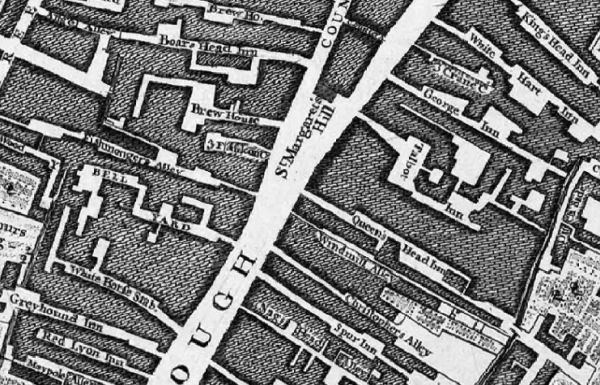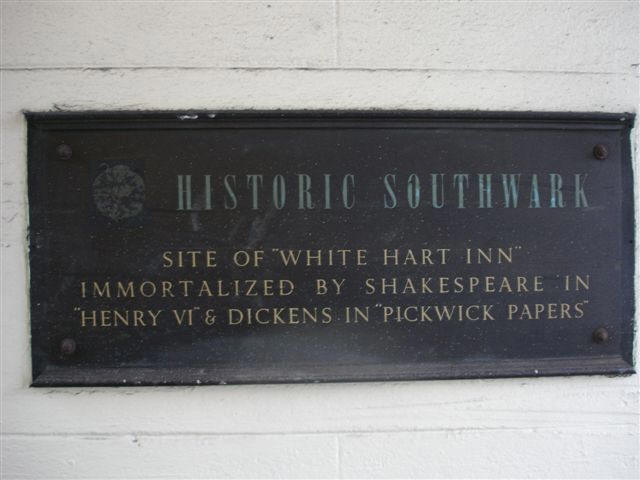

Search london history from Roman times to modern day
Southwark St Saviour pub history index
Southwark being on the high road to the coast and to Canterbury, which contained the famous shrine of St. Thomas à Becket, was for centuries occupied by inns in number out of all proportion to ordinary shops and dwellings.
The Borough, according to a State Paper of 1619, "consists chiefly of inn-keepers." John Stow, in his Survey (1598), says, "from thence (the Marshalsea) towards London Bridge on the same side, be many fair inns for the receipt of travellers; by these signs: the Spurre, Christopher, Bull, Queen's Head, Tabard, George, Hart, King's Head," etc. Of older date (about 1542) is a map of Southwark, to be found among the Duchy of Lancaster Records in the Record Office, which shows almost all the more important Southwark inns. They were grouped together chiefly on the east side of what is now called the Borough High Street, the most distant not being more than a quarter of a mile apart. These inns had a gateway from the street, which was closed at night. Passing through this gateway one entered a yard, round which ran the galleries where the guests were housed. Beyond this again there was a larger yard, which contained the stabling, and where there were often various tenements. This was approached by a passage from the outer yard, and generally there was also access to it from behind.
The White Hart was perhaps the largest Southwark inn, and appears to have dated from the latter part of the 14th century, the sign being the badge of Richard II., derived from his mother, Joan of Kent. In the summer of 1450 it was Jack Cade's headquarters whilst he was striving to gain possession of London. Hall, in his Chronicle, thus speaks of him:—"The capitayn being advertized of the kynge's absence came first into Southwarke, and there lodged at the White Hart, prohibiting to all men Murder, Rape, or Robbery; by which colour he allured to him the hartes of the common people." It must have been by his orders, if not in his presence, that "at the Whyt harte in Southwarke, one Hawaydyne of sent Martyns was beheaded," as we are told in the Chronicle of the Grey Friars. Here, too, Sir John Fastolfe's servant, Payne, was despoiled and threatened with death. Cade's success was of short duration: his followers wavered; he said, or might have said, in the words of Shakespeare (2 Henry VI., act iv., sc. 8), "Hath my sword therefore broke through London gates that you should leave me at the White Hart in Southwark?" The outbreak collapsed, and our inn is not heard of again for many years. In 1529 a message was sent to Thomas Cromwell, the notorious minister of Henry VIII., by some one asking for an interview at the White Hart. In 1669 the back of the inn was burnt down; and on May 26, 1676, a most destructive fire occurred in Southwark, when according to the best authorities, no fewer than 500 houses were either burnt or blown up. The White Hart was quite destroyed, but was rebuilt shortly afterwards on the old foundations, at a cost of £2,400. In 1720 Strype describes it as "very large and of a considerable trade, being esteemed one of the best inns in Southwark," and it so continued until the early years of the 19th century. Charles Dickens, in the tenth chapter of Pickwick, has given us the following graphic description of the house when something of its old prosperity still clung to it:—
"In the Borough especially, there still remain some half dozen old inns, which have preserved their external features unchanged and which have escaped alike the rage for public improvement and the 3 encroachment of private speculation. Great, rambling, queer old places they are, with galleries, and passages, and staircases, wide enough and antiquated enough to furnish material for a hundred ghost stories. It was in the yard of one of these inns—of no less celebrated a one than the White Hart—that a man was busily employed in brushing the dirt off a pair of boots, early on the morning succeeding the events narrated in the last chapter. The yard presented none of that bustle and activity which are the usual characteristics of a large coach inn. Three or four lumbering wagons, each with a pile of goods beneath its ample canopy, about the height of the second floor window of an ordinary house, were stowed away beneath a lofty roof, which extended over one end of the yard; and another, which was probably to commence its journey that morning, was drawn out into the open space. A double tier of bedroom galleries, with old clumsy balustrades, ran round two sides of the straggling area, and a double row of bells to correspond, sheltered from the weather by a little sloping roof, hung over the door leading to the bar and coffee-room. Two or three gigs and chaise-carts were wheeled up under different little sheds and penthouses; and the occasional heavy tread of a cart-horse, or rattling of a chain at the further end of the yard, announced to anybody who cared about the matter, that the stable lay in that direction. When we add that a few boys in smock frocks were lying asleep on heavy packages, woolpacks, and other articles that were scattered about on heaps of straw, we have described as fully as need be, the general appearance of the yard of the White Hart Inn, High Street, Borough, on the particular morning in question."
In 1865-66 the south side of the building was replaced by a modern tavern, which appears to the right of drawing No. 2. Some years previously the yard had been disfigured by a penthouse or lean-to (also shown in this drawing), which was used for the business of a bacon dryer. The old galleries on the north and east sides were let out in tenements. In the inner yard were some quaint old houses crowded with lodgers (vide No. 6). From here, looking back, one often saw the smoke of the bacon curer's furnaces curling out of the windows of the main building (as shown in drawing No. 3). The remains of the old White Hart were pulled down in July 1889, and hop factors' rooms built on the site, the yard being very much curtailed. The modern tavern on the south side was closed some time ago. It is now used for the storage of goods. The only trace of its former associations (October 1912) is a painted board, still to be seen through one of the windows, with the following words painted on it:—the Sam Weller (Social) club.
The Morgans map of 1682 cofirms the existence of the White Hart Inne at that time. At 1 White Hart Yard in 1861 census; the 1842 directory places the White Hart at about 61 Borough High street. This historic Southwark St Saviours coaching inn is long gone, but a plaque marks the spot. ** The address is White Hart Inn Yard, 62 Borough High Street in 1869 and earlier, prior to street renumbering. *
A listing of historical London public houses, Taverns, Inns, Beer Houses and Hotels in Southwark St Saviour, Surrey, London.

Borough High Street in the Morgans map of 1682. On east side are 113 Kings Head Inne, 112 White Hart Inne, 111 Three Crown court, George Inne, 110 Talbot Inne, 109 Queens head Inne, 108 Cock & hoop alley, 107 Windmill alley, 106 Christopher alley , 105 Spurr Inne. On west side are 62 Malings yard, 63 Saints alley, 64 Great yard, 65 Fishmongerv alley, 66 Bell yard, 67 Windmill alley, 68 Whitehorse Inne, 69 Greyhound Inne, 70 Maypole alley.

Borough High Street in 1746. On east side are Kings Head Inn, White Hart Inn, Three Crane court, George Inn, Talbot Inn, Queens Head Inn, Windmill alley, Christopher alley, Spur Inn, Nags Head alley. On west side are Boars Head Inn, Brewhouse, Fishmongers alley, Bell Yard, White Horse stables, Greyhound Inn, Red Lyon Inn, Maypole alley.

Old White Hart, Southwark
Kindly provided by Colleen

Historic Southwark - Site of White Hart Inn immortalized by Shakespeare in Henry VI & Dickens in Pickwick Papers - in February 2007
Kindly provided by Stephen Harris
Residents at this address
Borough High Street in the Morgans map of 1682. On east side are 113 Kings Head Inne, 112 White Hart Inne, 111 Three Crown court, George Inne, 110 Talbot Inne, 109 Queens head Inne, 108 Cock & hoop alley, 107 Windmill alley, 106 Christopher alley , 105 Spurr Inne. On west side are 62 Malings yard, 63 Saints alley, 64 Great yard, 65 Fishmongerv alley, 66 Bell yard, 67 Windmill alley, 68 Whitehorse Inne, 69 Greyhound Inne, 70 Maypole alley.
In 1708 : A New View of London by Edward Hatton lists White Hart inn, on the East side of the Borough of Southwark, toward the South end. This is the largest sign about London, except the Castle Tavern in Fleet street.
Borough High Street in 1746. On east side are Kings Head Inn, White Hart Inn, Three Crane court, George Inn, Talbot Inn, Queens Head Inn, Windmill alley, Christopher alley, Spur Inn, Nags Head alley. On west side are Boars Head Inn, Brewhouse, Fishmongers alley, Bell Yard, White Horse stables, Greyhound Inn, Red Lyon Inn, Maypole alley.
1811/Joseph Langdon, White Hart Inn, Borough/../../Holdens Directory
1817/William Whiten/ Inn holder/../../Johnstones London Directory
1822/Joseph Rose/../../../Victuallers Recognizance
1823/Joseph Rose/../../../Victuallers Recognizance
1825/Edward Norman/../../../Victuallers Recognizance
1826/Edward Norman/../../../Victuallers Recognizance
1832/Stanbury & Hoare/../../../Robsons Directory
1841/H. Gander/../../../Post Office Directory *
1842/R Gosbey/../../../Robsons Directory
January 1848/William Henry Brown/Outgoing Licensee/../../Era Newspaper
January 1848/Thomas Suelns?/Incoming Licensee/../../Era Newspaper
September1850/Henry Edward Murrell/Outgoing Licensee/../../Era
September 1850/John Neighbour/Incoming Licensee/../../Era
1851/George Dowling/Licensed Victualler/31/Southwark, Surrey/Census
1851/Elizabeth Dowling/Wife/32/Camberwell, Surrey/Census
1851/Alfred Dowling/Son/3/Southwark, Surrey/Census
1851/Isabella Dowling/Daughter/1/Southwark, Surrey/Census
1851/James Dowling/Son/5 months/Southwark, Surrey/Census
1851/Frederick Dowling/Brother/22/Worthing, Sussex/Census
1851/Elizabeth Dowling/Sister in Law/23/Brighton, Sussex/Census
1851/Frederick Dowling/Nephew/1/Lambeth, Surrey/Census
1851/Emelier Brooks/Visitor/13/Southwark, Surrey/Census
1851/Mary A Down/Charwoman/22/Southwark, Surrey/Census
1851/Mary Hilton/Nurse/53/Worcester/Census
1851/Alfred Beale/Waiter/18/Frant, Kent/Census
April 1853/George Dowley/Outgoing Licensee/../../Era
April 1853/Thomas Stephen Lansdell/Incoming Licensee/../../Era
July 1853/Thomas Stephen Lansdell/Outgoing Licensee/../../Era
July 1853/William Barling Sharpe/Incoming Licensee/../../Era
1856/William Springett/../../../Post Office Directory
1861/William Springett/Licensed Victualler/40/Wittersham, Kent/Census
1861/Bedelice Springett/Wife/40/Bristol, Somerset/Census
1861/Albert Springett/Nephew, Bacon Dryers Clerk/19/Appledore, Kent/Census
1861/Elizabeth Springett/Sister/38/Wittersham, Kent/Census
1861/Robert Winstone/Nephew/13/Somerset/Census
1861/Bessie Marchant/Chambermaid/19/London, Middlesex/Census
1861/Elizabeth Heard/Kitchenmaid/17/Newington, Surrey/Census
+ Lodgers
March 1863/Jacob Mas/Outgoing Licensee/../../Era
March 1863/Joseph Barnett and Andrew Barnett/Incoming Licensee/../../Era
April 1865/late tenant quit/Outgoing Licensee/../../South London Chronicle
April 1865/Frederick Hollis Plummer/Incoming Licensee/../../South London
Chronicle
1869/Joseph White/../../../Post Office Directory
South London Press 27 March 1875 - The following were refused new victuallers licenses:
Frederick William White, the White Hart, 63 High street
1881/Samuel Renaut/Licensed Victualler/38/Westminster, Middlesex/Census
1881/Emma Renaut/Wife/31/Bromley, Middlesex/Census
1881/Florence Renaut/Daughter/8/Islington, Middlesex/Census
1881/Herbert Renaut/Son/7/Islington, Middlesex/Census
1881/Emma A Renaut/Daughter/5/London City, Middlesex/Census
1881/Bertram F Renaut/Son/3/London City, Middlesex/Census
1881/Edith M Renaut/Daughter/1/London City, Middlesex/Census
1881/Lotty L Renaut/Daughter/1 month/London City, Middlesex/Census
1881/Mary Taylor/Barmaid/21/Windsor, Berkshire/Census
1881/Alice Dunn/Barmaid/22/Holloway, Middlesex/Census
1881/Elizabeth Watson/Nurse/25/Stepney, Middlesex/Census
1881/Caroline Stephens/Nurse/16/Horselydown, Surrey/Census
1881/Sarah Brydges/Housemaid/25/Southwark, Surrey/Census
1881/Norah Murphy/Cook/16/Aldgate, Middlesex/Census
1881/Ellen Storer/Kitchenmaid, Widow/31/Carshalton, Surrey/Census
1881/Stephen Collins/Waiter/24/Walworth, Surrey/Census
1881/Robert Lee/Porter/42/Southwark, Surrey/Census
1881/James Golding/Under Waiter/16/Kentish Town, Middlesex/Census
1882/Samuel Renaut/../../../Post Office Directory
1895/James Temple/../../../Post Office Directory *
1899/William James Williams/../../../Post Office Directory
1901/Angelo L Gargini/Publican/51/Genova Thala, Italy/Census
1901/Giacome Gargini/Son/23/Camden Town/Census
1901/Rosie Gargini/Daughter/21/Camden Town/Census
1901/Lola Gargini/Daughter/19/Camden Town/Census
1901/Assilio Gargini/Son/17/Camden Town/Census
1901/Annie Folkey/Barmaid/21/Kennington, London/Census
1901/Edward Cressi/Billiard Marker/31/Marylebone, London/Census
1901/Lingi Fassione/Liftman/20/Verolengo, Italy/Census
1901/Bassistesca Severin/Kitchenmaid/20/Como, Italy/Census
1901/Assilio Cardini/Waiter/20/Beveno, Italy/Census
Giacome Gargini is at the
White Hart
Hotel, Buckingham by the 1911 census
London Evening Standard 28 October 1908
Licensing Act 1904 Notice of principal meeting to discuss by the Compensation authority on the 6th, 7th, 8th and 9th July 1908
Newington
White Hart Inn, White Hart Inn yard, St Saviour, Full (6 days), Frank Doddrell
* Provided By Ewan
** Provided By Stephen Harris
Trying to avoid privacy and cookie settings overwriting content